-
Posts
1,267 -
Joined
-
Last visited
Reputation Activity
-
 AnobiumPunctatum got a reaction from FrankWouts in HMS Winchelsea - FINISHED - 1764 - by Chuck (1/4" scale)
AnobiumPunctatum got a reaction from FrankWouts in HMS Winchelsea - FINISHED - 1764 - by Chuck (1/4" scale)
Scuppers in German means "Speigatten"
-
 AnobiumPunctatum reacted to JpR62 in HM Cutter Cheerful 1806 by JpR62 - 1:48 scale
AnobiumPunctatum reacted to JpR62 in HM Cutter Cheerful 1806 by JpR62 - 1:48 scale
Thank you to all the 'Likes'.
The two forward chase ports were cut after determining their position on the filler pieces.
The opening is slightly smaller than the final measurements. The openings are then sanded with sanding blocks manufactured to the correct dimensions.
I will probably cover the wood with a thin coat of 'Gesso' before doing a final sanding with very fine sandpaper.
But the next step will be to cut out the space that will house the two rooms.
-
 AnobiumPunctatum got a reaction from FrankWouts in HMS Winchelsea 1:48 by Ron Burns
AnobiumPunctatum got a reaction from FrankWouts in HMS Winchelsea 1:48 by Ron Burns
Your counter is looking really nice.
-
 AnobiumPunctatum got a reaction from GrandpaPhil in HM Cutter Cheerful 1806 by AnobiumPunctatum - scale 1/48
AnobiumPunctatum got a reaction from GrandpaPhil in HM Cutter Cheerful 1806 by AnobiumPunctatum - scale 1/48
In 2016 I bought Chuck's Starting set from a fellow modeler who became a father. I glued the false keel together and then packed everything in a big box. While preparing the Winchelsea build, the box fell into my hands and I decided to build both models more or less in parallel. I can practise all the building steps on the much smaller Cheerful model before I do them on the Winchelsea.
Since the false keel I built at that time was no longer usable and I want to build the model from Yellow Cedar, I asked Chuck for spare parts. These arrived on Saturday morning with a small delivery of wood. Many thanks for the first class service, @Chuck .
I will build the model according to the instructions and with the help of the mini-kits. I have only one change planned - I want to copper the underwater hull.
The slipway is a bit big for the small cutter, but as I still had it, it was reactivated.
On Saturday evening I glued the false keel together and let it dry overnight. The frames could only be pushed into the recesses with difficulty - the thickness of plywood is always subject to slight fluctuations. I made a small sanding stick out of 180-grit sandpaper and a suitable strip. Then go over the lasered edges two or three times on each side and the frames fit perfectly (the frames are not glued in now).
Finally, the stem was assembled.
-
 AnobiumPunctatum reacted to bartley in HM Cutter Cheerful 1806 by bartley - FINISHED - 1/48 scale
AnobiumPunctatum reacted to bartley in HM Cutter Cheerful 1806 by bartley - FINISHED - 1/48 scale
Post 49: Rigging the Bowsprit
4 blocks need to be installed on the the ring-bolts at the end of the bowsprit:
The bobstay needs a block with a becket seized on one end. My method is established from several posts on this site but I include it here for completeness
I start by forming the becket. I do this by wrapping the line around an appropriate sized drill, passing a needle through the line an pulling it tight
I seal this with a drop of CA and stiffen the becket with shellac.
Now I add the block and glue it to the line with PVA. Then I begin the false splice by fraying the ends cutting them on the diagonal, adding a drop of PVA and rolling the splice between my fingers
Since this bobdstay is seved for its whole length I serve over the splice as well
In order to thicken the splice a little I wound some 0.3 mm line just over the splice itself.
The other end of the bobstay is spliced to the stem in a similar way and then the block is reeved to the lower 3/16double block on the end of the bowsprit.
The bowsprit guys were made in a similar way but spliced onto thimbles. a hook fabricated from 24 gauge wire was added to the outer The whole assembly was attached as shown in the plans between the ring-bolt at the and of the bowsprit and the ring bolt in the bow of the hull
None of these was tightened at this stage. I will wait until the rest of the bowsprit rigging is in place.
John
-
 AnobiumPunctatum reacted to Ron Burns in HMS Winchelsea 1:48 by Ron Burns
AnobiumPunctatum reacted to Ron Burns in HMS Winchelsea 1:48 by Ron Burns
Man do I feel like a dummy!!! I measured everything! I printed off every bulkhead in both 300dpi and 600dpi thinking my printer was at fault. I measured the distance from top of the bulkhead to the bottom of the wales, the bottom of the wales to bottom of the keel and compared each measurement to the digital print takeoff and everything was on the money or +- .5 of a millimeter once or twice. And the prize goes to Christian!! After scratching my head, cussing some more and getting yelled at by my wife, I checked my wood pile. My 1/4 inch stuff is about 30 feet x 4.5 inches x 15/64 inches!. After a bevel and a bit of a sand we have just over by a hair 7/32. As you can guess my Tourette's came back with a vengeance and my wife was yelling at me again
My Winnie is naked again as I took Tom's advice and started over. I just couldn't live with the 'close enough, fake it' thing. Winnie and friends deserve better!
-
 AnobiumPunctatum reacted to FrankWouts in HMS Winchelsea 1764 by Frank Wouts 1/48
AnobiumPunctatum reacted to FrankWouts in HMS Winchelsea 1764 by Frank Wouts 1/48
Tadaa, yes here it is finally, after crossing the atlantic! Happy as can be!
-
 AnobiumPunctatum got a reaction from KenW in HMS Winchelsea - FINISHED - 1764 - by Chuck (1/4" scale)
AnobiumPunctatum got a reaction from KenW in HMS Winchelsea - FINISHED - 1764 - by Chuck (1/4" scale)
Scuppers in German means "Speigatten"
-
 AnobiumPunctatum reacted to Vladimir_Wairoa in HMS Winchelsea - FINISHED - 1764 - by Chuck (1/4" scale)
AnobiumPunctatum reacted to Vladimir_Wairoa in HMS Winchelsea - FINISHED - 1764 - by Chuck (1/4" scale)
I would humbly inexperiencely think coppering would ruin beauty and philosophy behind it for me. and cover palnking . im with Greg. elegant with simplicity. its same logic applied as going with treenails. posibilities are endless. - fully ? partially with framing ? one side? I would for sure not put scuppers on mine. Im eager to see how top deck would look like apart of cannons. Would there be those crossbeams like on greenwich model we see? only Chuck knows im looking forward to explore it as it goes....
-
 AnobiumPunctatum got a reaction from GrandpaPhil in HM Cutter Cheerful 1806 by AnobiumPunctatum - scale 1/48
AnobiumPunctatum got a reaction from GrandpaPhil in HM Cutter Cheerful 1806 by AnobiumPunctatum - scale 1/48
Next step was to form the rabbet. I used therefor a scrap piece from the false keel.
After drying, the spooning was glued to the false keel. During the drying process the paper clips proved their worth.
I sanded the taper the stem with sandpaper. Finally, the stem and keel were glued to the ensemble.
As you can see in the photos, the shape of the taper is not perfect, but the planking will cover that later.
-
 AnobiumPunctatum got a reaction from FrankWouts in HMS Winchelsea - FINISHED - 1764 - by Chuck (1/4" scale)
AnobiumPunctatum got a reaction from FrankWouts in HMS Winchelsea - FINISHED - 1764 - by Chuck (1/4" scale)
If you like to copper HMS Winchelsea, I am quite sure that you have to follow the appearence of the Minerva model, this means that you have to change the design from Chuck. Chucks design shows the ship before the large repair. During this repair from 03/1780 until 04/1782 the ship was coppered.
I like to rig my model, because I love the appearance of a "fully" rigged frigate. But until I reach this stage I have a lot to do and much more to learn.
-
 AnobiumPunctatum got a reaction from dvm27 in HMS Winchelsea - FINISHED - 1764 - by Chuck (1/4" scale)
AnobiumPunctatum got a reaction from dvm27 in HMS Winchelsea - FINISHED - 1764 - by Chuck (1/4" scale)
If you like to copper HMS Winchelsea, I am quite sure that you have to follow the appearence of the Minerva model, this means that you have to change the design from Chuck. Chucks design shows the ship before the large repair. During this repair from 03/1780 until 04/1782 the ship was coppered.
I like to rig my model, because I love the appearance of a "fully" rigged frigate. But until I reach this stage I have a lot to do and much more to learn.
-
 AnobiumPunctatum got a reaction from glbarlow in HM Cutter Cheerful 1806 by glbarlow - FINISHED - 1:48
AnobiumPunctatum got a reaction from glbarlow in HM Cutter Cheerful 1806 by glbarlow - FINISHED - 1:48
Nicely done.
-
 AnobiumPunctatum got a reaction from JpR62 in HMS Winchelsea - FINISHED - 1764 - by Chuck (1/4" scale)
AnobiumPunctatum got a reaction from JpR62 in HMS Winchelsea - FINISHED - 1764 - by Chuck (1/4" scale)
If you like to copper HMS Winchelsea, I am quite sure that you have to follow the appearence of the Minerva model, this means that you have to change the design from Chuck. Chucks design shows the ship before the large repair. During this repair from 03/1780 until 04/1782 the ship was coppered.
I like to rig my model, because I love the appearance of a "fully" rigged frigate. But until I reach this stage I have a lot to do and much more to learn.
-
 AnobiumPunctatum got a reaction from EricWilliamMarshall in HM Cutter Cheerful 1806 by AnobiumPunctatum - scale 1/48
AnobiumPunctatum got a reaction from EricWilliamMarshall in HM Cutter Cheerful 1806 by AnobiumPunctatum - scale 1/48
Next step was to form the rabbet. I used therefor a scrap piece from the false keel.
After drying, the spooning was glued to the false keel. During the drying process the paper clips proved their worth.
I sanded the taper the stem with sandpaper. Finally, the stem and keel were glued to the ensemble.
As you can see in the photos, the shape of the taper is not perfect, but the planking will cover that later.
-
 AnobiumPunctatum got a reaction from Ryland Craze in HM Cutter Cheerful 1806 by AnobiumPunctatum - scale 1/48
AnobiumPunctatum got a reaction from Ryland Craze in HM Cutter Cheerful 1806 by AnobiumPunctatum - scale 1/48
Next step was to form the rabbet. I used therefor a scrap piece from the false keel.
After drying, the spooning was glued to the false keel. During the drying process the paper clips proved their worth.
I sanded the taper the stem with sandpaper. Finally, the stem and keel were glued to the ensemble.
As you can see in the photos, the shape of the taper is not perfect, but the planking will cover that later.
-
 AnobiumPunctatum got a reaction from Edwardkenway in HM Cutter Cheerful 1806 by glbarlow - FINISHED - 1:48
AnobiumPunctatum got a reaction from Edwardkenway in HM Cutter Cheerful 1806 by glbarlow - FINISHED - 1:48
Nicely done.
-
 AnobiumPunctatum got a reaction from Rustyj in HMS Winchelsea - FINISHED - 1764 - by Chuck (1/4" scale)
AnobiumPunctatum got a reaction from Rustyj in HMS Winchelsea - FINISHED - 1764 - by Chuck (1/4" scale)
If you like to copper HMS Winchelsea, I am quite sure that you have to follow the appearence of the Minerva model, this means that you have to change the design from Chuck. Chucks design shows the ship before the large repair. During this repair from 03/1780 until 04/1782 the ship was coppered.
I like to rig my model, because I love the appearance of a "fully" rigged frigate. But until I reach this stage I have a lot to do and much more to learn.
-
 AnobiumPunctatum reacted to glbarlow in HM Cutter Cheerful 1806 by glbarlow - FINISHED - 1:48
AnobiumPunctatum reacted to glbarlow in HM Cutter Cheerful 1806 by glbarlow - FINISHED - 1:48
The Boom Crutches
I had to sort through how to get started on the boom crutches, the monograph picks up with how to approach the angles, which is essential to the process, but has the basic crutch already made, I had to figure out how to get to that point. I started with some rectangular blanks of ¼ sheet cut a little larger than the finished width and height then, with my pencil and paper constructed a series of measurements and lines to work from to create the initial Y. I suppose some can free-hand such things, I cannot. I wanted a precise beginning to get me to a precise end.
I used a router bit on the mill for the half circle and the jewelers saw with the blanks in my small vise to cut out a starting point. As Chuck points out these need to be extra thick, the ¼ barely covers it. The reason is distinct angles that have to be accounted for and the resulting sanding and cutting to get those. The monograph starts with the side, I found it easier after a couple of false starts to start with the back angle first, then the side then the front. The two remaining angles, the top and the turn in towards the mast are best done after mounting.
I had to get it to a size that seemed in scale. The crutches are not on the plans so I was eyeballing it based on the monograph photos and mostly what looked right to me. I went through several of my blanks, in fact I got one (show in the photo) very close to a final product only to decide it was two wide, so out it went.
Once I sorted out a process and the scale and finally got one about 50% near what I wanted I stopped and made the second one. One of the many challenges of these things is making the second one identical to the first. My approach, rather than finish one at a time was to bring two along together. There is a lot, a lot, of sanding to get from the Y blank to the shape and size I wanted and get the angles needed. I kept the two in balance with frequent measurements at key points with digital calipers, and kept track on a series of small papers (only the final one is shown) kept next to the sanding tools. I used of different grits, blocks, sticks and holders and a needle file or two here and there. It took two days of taking my time, slowly reducing the blanks into identical crutches resulting in what the photo shows finally attached to the stern then finished it all off with wood filler along the seams of the stern rail. Did I mention there was a lot of sanding.
I recommend this approach. Rather than make one and copy it, make two together, reducing and shaping slowly just tenths of millimeters at a time. As I noted, I had several false starts on the first one - but once I had the basic Y blank right I had no repeats on the second crutch. I pinned and glued them on then made the final adjustments, filing the tops parallel to the water line and then turning them inward on the angle the boom, connected to the mast, would rest, Finally I lightly smoothed and rounded all the edges and it was ready to paint.
Stern Complete
I’ve reached something of a milestone. The stern of my Cheerful is complete. I’m pretty happy with how its turned out so far. One challenge after another has been met, I’ve learned more new things than I can count and used tools I didn’t know I needed (ok, wanted). I have more challenges ahead, like how to shape and file brass strip for the stays which is up next. So I’m off to do that, but I can look back (see what I did there) and see a portion of the hull now finished.
Thanks for stopping by.
-
 AnobiumPunctatum got a reaction from Matt D in HM Cutter Cheerful 1806 by AnobiumPunctatum - scale 1/48
AnobiumPunctatum got a reaction from Matt D in HM Cutter Cheerful 1806 by AnobiumPunctatum - scale 1/48
Next step was to form the rabbet. I used therefor a scrap piece from the false keel.
After drying, the spooning was glued to the false keel. During the drying process the paper clips proved their worth.
I sanded the taper the stem with sandpaper. Finally, the stem and keel were glued to the ensemble.
As you can see in the photos, the shape of the taper is not perfect, but the planking will cover that later.
-
 AnobiumPunctatum got a reaction from JpR62 in HM Cutter Cheerful 1806 by AnobiumPunctatum - scale 1/48
AnobiumPunctatum got a reaction from JpR62 in HM Cutter Cheerful 1806 by AnobiumPunctatum - scale 1/48
Next step was to form the rabbet. I used therefor a scrap piece from the false keel.
After drying, the spooning was glued to the false keel. During the drying process the paper clips proved their worth.
I sanded the taper the stem with sandpaper. Finally, the stem and keel were glued to the ensemble.
As you can see in the photos, the shape of the taper is not perfect, but the planking will cover that later.
-
 AnobiumPunctatum reacted to Chuck in HMS Winchelsea - FINISHED - 1764 - by Chuck (1/4" scale)
AnobiumPunctatum reacted to Chuck in HMS Winchelsea - FINISHED - 1764 - by Chuck (1/4" scale)
TO SCUPPER OR NOT TO SCUPPER!!!! Whats been on my mind as I study and read and develop as a ship modeler.
As you guys know by now, I am taking a somewhat minimalist approach to my model of the Winchelsea. Although I have still included more details for a "kit" project of a frigate than any such project on the market today. Minimalist might not be the best word for it. But like any painter who studies the original master works of old, I have chosen to take a deep study of those masters of our craft for my model.
I have shown the scuppers and the drains for the pumps and manger on the plans....but if this project has achieved anything, I hope it has given you that same sense of admiration for the model makers of the 18th century. I hope I have convinced many of you not to take just a passing glance at these beautiful works but instead really study them. Study them for the details that they chose to add as well as those details they chose to omit. The finished works of these early masters are quite beautiful to me in that they dont "kitchen sink" their models. The end result is pleasing to the eye because you are left with an overall picture of the graceful lines, colors and shapes on the finished models. The beauty is not lost because of the vast number of details added just because you can add them....or just because it might show others that your knowledge of such details is very broad.
Have a look at as many contemporary models as you can look at....I defy any of you to find one example of a contemporary frigate model that shows the scuppers. I think they would lessen the appearance and beauty of the sheer profile because it would be distracting somewhat. I think the the original masters knew this as well, because it is not difficult to add these details. But you would be hard pressed to spot any old master works with them.
So I will omit them on my Winnie but you guys can decide if you would like to add this feature among the others I am omitting. I dont want to hinder your desire to add these features because of my personal decision to go minimalist on this go-around. So this completes Chapter 5 and I will start production of the parts for you guys. Next up will be gun carriages and eyebolts for them along the bulwarks. But if you want to add them.....this would be the best time to add those scuppers.
Just some inspiration below!!!! And a great conversation and worth further discussion.....As someone who schooled to become a painter at one of most prestigious art schools, this question was something we also discussed. I think based on the "trend" with current models being developed...it is a very timely question for us as artists of this craft to start asking.
-How much detail becomes too much detail?
-Should I add every detail to show I have the knowledge of such things?
-Should I add them to show others I have the skills to create them with high levels of craftsmanship?
-Will they detract from the final work of ART?
-How necessary to the finished model are these details?
-Is my goal to make as close a miniature representation of the original as possible, or is it to make a as beautiful a representation as I imagine it to be?
-Have modelling trends gone too far simply because the technology to create them has made it easier to do so, does this make for a better object de art? Or just "because we can?"
Anyway....these are the questions that are suddenly on my mind as I develop these projects as of late. I hate to get all philosophical, BUT I have been studying and reading a lot about the early painters I admire lately and it has crossed over into my thinking about current trends in ship modelling. I would love to hear your thoughts??? Especially from those more experienced builders.
Having said that.....here is one of the very few examples where they are shown. I will leave it to you to decide.
Although this example is a bit later and much smaller ship....a sloop of 22 guns if memory serves me correct.
-
 AnobiumPunctatum got a reaction from FrankWouts in HMS Winchelsea - FINISHED - 1764 - by Chuck (1/4" scale)
AnobiumPunctatum got a reaction from FrankWouts in HMS Winchelsea - FINISHED - 1764 - by Chuck (1/4" scale)
These are very interesting news. I like the color of the yellow ceda. I think it will be looking really nice with my favorite pear wood and a nice choice for my HMS Triton. But in the moment I don't have any idea where to buy tis kind of timber in Europe.
I like the idea of building the model in 1/48. So it has the same scale as my other projects.
-
 AnobiumPunctatum reacted to JpR62 in HM Cutter Cheerful 1806 by JpR62 - 1:48 scale
AnobiumPunctatum reacted to JpR62 in HM Cutter Cheerful 1806 by JpR62 - 1:48 scale
Thank you to all the 'Likes'.
Today, I proceeded to mark the position of the gunport sills.
Two thin battens were placed temporarily following the reference lines of each bulkhead. Slight adjustments were then necessary to obtain a smooth run from bow to stern. It was also necessary to try to obtain the same line on both sides of the hull.
Once I was satisfied with the position of the two battens, I drew a line above the batten on each bulkhead with a sharp pencil. The batten strips were then removed.
I will now proceed to cut the 2 forward chase ports that will be located on the filler pieces at the bow.
-
 AnobiumPunctatum reacted to Tankerman in Seawatch Books
AnobiumPunctatum reacted to Tankerman in Seawatch Books
No they are not, this month I have had two packages from the EU with no import charges applied, one from the USA and one from Australia with the normally expected charges applied. Please keep politics out of it.




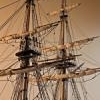
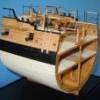
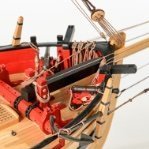

.thumb.jpeg.fc5d633a7b34428fcf19419a73d56d55.jpeg)

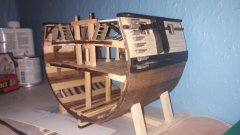
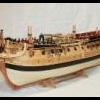
.thumb.jpg.6d6ee4bdbfaac2c58ecc77e7b80ae374.jpg)